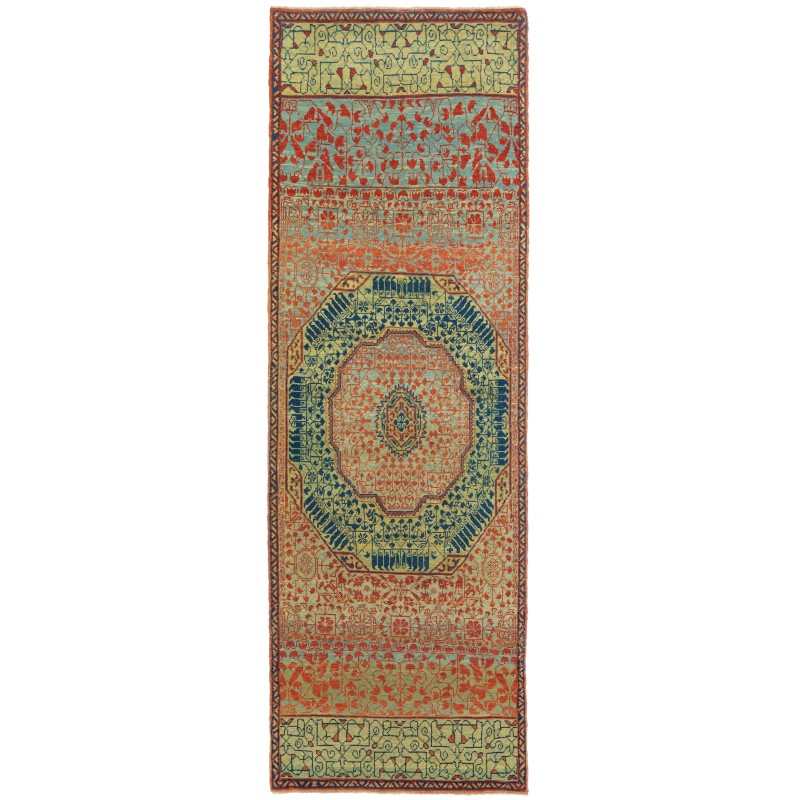
- Stock: 売り切れ
- Model: C50271
- サイズ: 233cm x 77cm
- SKU: ART271
ジェレヒアン・マムルークの絨毯は、エジプト・カイロのマムルーク・スルタンによって16世紀初頭にデザインされたものです。この絨毯は特異なボーダーを持っており、最初は複雑な幾何学的な絡み合いに見えます。最も一般的なマムルークのボーダーは、ラウンデルとカルトゥーシュのセグメントが交互に配置されたものです。絹のテキスタイル博物館のR7.7とR7.16にも絡み合いのパターンが見られます。もしこのマムルークが16世紀初頭にデートするのが正しいとすれば、ジェネバの絨毯と同時代の可能性があり、モデルとなったかもしれません。ジェネバの絨毯やチェッカーボード、パラ・マムルークなどを含め、マムルークの絨毯パターンとオスマン時代の絨毯パターンとの関連性が強まるかもしれません。
カイロの工房で生産された初期の絨毯を読み解こうとすることは、まったく異なる一連の課題を提供します。カイロの絨毯は、限られたカラーパレット、対称的な結び目、そしてS-紡毛(イスラム世界のほとんどで通常のZ-紡毛が使用される)の異常な構造で特徴付けられます。これらの絨毯は、オスマン・トルコが1517年にマムルーク帝国を征服した後、デザインに急激な変化を遂げました。シモネッティ・カーペットは征服後に織られたものであり、マムルークの「古い」15世紀のスタイルを展示しています。細長く、エジプトの標準サイズのローラービーム織機で織られ、異なる長さの絨毯を生産することができます。絨毯はA-B-C-B-Aのパターンで5つの主要なデザインの焦点エリアから構成されており、第1と第5のエリア、第2と第4のエリアはペアになっており、中央は独自のデザインです。これらの5つの焦点エリアはメダリオンと呼ばれることもありますが、レイアウトとディテールの両方で幾何学的であり、そのスタイルは実際の織りの日付よりもメダリオン形式が生まれる前のものです。マムルークの絨毯のデザインと色彩は、赤、青、緑、そして時には黄色という異常な組み合わせの色彩で、ほとんど無染色の白がないことから、初期の近代市場で認識可能なブランドを作り出す努力の一環であると考えられます。特にヨーロッパでは、このようなマムルークの絨毯は、微妙な色彩、非常に詳細なデザイン、そして小さく複雑な幾何学的なモチーフのモザイクのような配置により、アナトリアのより荒く織られ、鮮やかな色彩のウシャク・メダリオンのような絨毯に対する魅力的な代替品となりました。伝統的な幾何学的なマムルークのデザインの絨毯の織りは、17世紀に入っても続いたようですが、16世紀半ば頃から、カイロの織り手たちは、伝統的なマムルークの材料、技術、色彩を使用しながら、イスタンブールのオスマン・スルタンの宮廷で作られていた最新のスタイルを反映したまったく新しい種類の絨毯を作り始めました。絨毯のデザインは私たちのデザイナーによって解釈され、ソフトな色彩がこの絨毯に選ばれました。
The source of rug comes from the Jerrehian Collection of Oriental Weavings. This rug with an unusual border was designed in the early 16th-century rug by Mamluk Sultane of Cairo, Egypt. The border initially appears to be a complex, geometric interlacing. The most common Mamluk border is one with alternating roundel and cartouche segments. Interlacing patterns are noted in Textile Museum R7.7 and R7.16,
If the dating of this Mamluk to the beginning of the l6th century is correct, it is a type that could have been contemporary to the Geneva rug and served as a model. A link between Mamluk rug patterns and those of the Ottoman period, as evidenced by the Geneva rug and others such as the checkerboard and Para-Mamluks, may be strengthened.
Attempting to read early carpets produced in workshops in Cairo provides an entirely different set of challenges. Cairene carpets, distinguished by their limited color palette, symmetrical knotting, and unusual construction of S-spun wool (Z-spun wool being the norm almost everywhere in the Islamic world), underwent a sudden change in design sometime after the Ottoman Turks conquered the Mamluk Empire in 1517. The Simonetti Carpet was probably woven after the conquest but exhibits the “old” fifteenth-century style of the Mamluks. Long and narrow, it was woven on a standard-sized Egyptian roller-beam loom, capable of producing carpets of varying lengths. It consists of five major focal areas of design in an A-B-C-B-A pattern, meaning the first and fifth and the second and fourth areas are paired, while the middle is unique. We can easily term these five focal areas medallions, but they are geometric in both layout and detail, and their style (as opposed to the actual date of the weaving) predates the carpet design revolution that gave rise to the medallion format. We can surmise that the designs and colors of Mamluk carpets, with their unusual combination of insect-derived red, blue, green, and sometimes yellow, with virtually no undyed white at all, constitute an effort to create a recognizable brand in the early modern market, especially in Europe, where Mamluk carpets such as this, with their subtle coloration, incredibly detailed design, and mosaic-like layout of small and intricately patterned geometric motifs, constituted an appealing alternative to the more coarsely woven and brightly colored carpets from Anatolia, such as Ushak medallion carpets. While the weaving of carpets in the traditional geometric Mamluk designs apparently continued well into the seventeenth century, sometime around the mid-sixteenth century, Cairene weavers began to create an entirely new kind of carpet, using their traditional Mamluk materials, technique, and coloration but reflecting the latest styles then being created at the court of the Ottoman sultans in Istanbul. The design of the rug is interpreted by our designers, and soft colors are chosen for this rug.
全部で4色使っています。
- Gunmetal Blue 409 (藍)
- Emerald Green 407 (カモミール - 藍)
- Turquoise 330 (トウダイグサ - 茜 - 藍 - クルミの殻)
- Congo Pink 306 (茜)
上の番号は私たちのカラーコードです。()の中は、主な草木染めの材料です。
